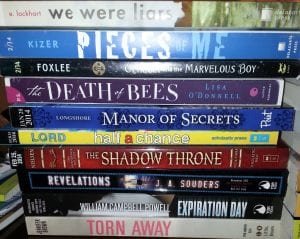A Conversation
A few weeks ago, I met with the two student teachers who have taken my methods courses and now I am supervising. We talked about acclimating to the classroom, which is different in the spring semester than in the fall. What is going well? Have they selected the class to focus on for their edTPA video recordings? What kinds of plans are they wanting to implement as they gradually take over different classes?
The response to this last question intrigued me:
I want to do something with the brown bag exam from our summer course.

Stack of books from 2014 NCTE Annual Meeting – examples of genres in YA Lit course
The Context
I was first introduced to the brown bag exam in Jennifer Buehler‘s text Teaching Reading with YA Literature: Complex Texts, Complex Lives. During summers 2017 and 2018, pre-service candidates and inservice teachers in my Young Adult Literature course (an English content course with a teacher education focus) saw this brainstorming technique in two assignments:
- “Brown Bag Exam”—Select an object. One per student and only one student per object. In the Question response, brainstorm connections between your selected object and The Sun Is Also a Star. Dig into the text. Pose questions.
- How might you create a “Brown Bag Exam” for your choice YA novel? Describe at least 5 items you would include. Discuss rationale for these items.
In the first assignment, I collected the objects (pictures) to share with the class. They engaged in the work as their own students might by selecting an object and writing about it. For the second iteration, I wanted them to design a brown bag exam as a teacher might do, just as I had done in the first assignment.
Research Connections
This conversation with my student teachers encouraged me to think about the connections among university courses and K-12 classrooms. We want strong connections to exist among content, methods courses, and teacher instruction; yet, how many reading, writing, management strategies or creatively-designed assessments persist beyond the final submissions at the university?
I decided to find out. This conversation inspired me to study how influential the Young Adult Literature course has been in teachers’ book selections, classroom libraries, and assignment designs.
One conversation. One research question. In the everyday.
Have you researched similar questions? Let me know what inspires you.